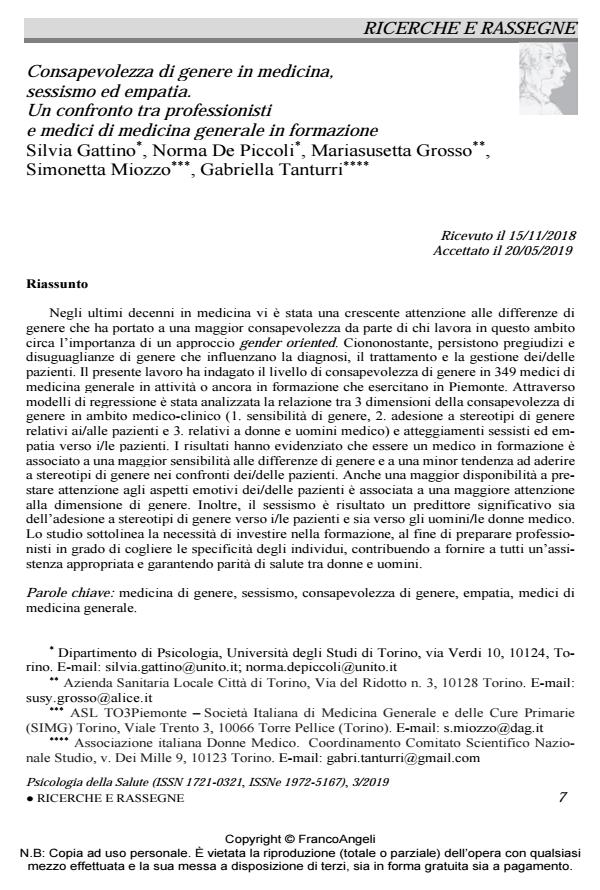Gender awareness in medicine, sexism and empathy. A comparison between professionals and general practitioners in training
Journal title PSICOLOGIA DELLA SALUTE
Author/s Silvia Gattino, Norma De Piccoli, Mariasusetta Grosso, Simonetta Miozzo, Gabriella Tanturri
Publishing Year 2019 Issue 2019/3
Language Italian Pages 21 P. 7-27 File size 284 KB
DOI 10.3280/PDS2019-003002
DOI is like a bar code for intellectual property: to have more infomation
click here
Below, you can see the article first page
If you want to buy this article in PDF format, you can do it, following the instructions to buy download credits

FrancoAngeli is member of Publishers International Linking Association, Inc (PILA), a not-for-profit association which run the CrossRef service enabling links to and from online scholarly content.
In the last decades in medicine, there has been a growing attention to gender differences that has led to a greater awareness by the health staff of the importance of a gender-oriented approach. Nevertheless, prejudices and gender inequalities persist which influence the diagno-sis, treatment and management of patients. This paper investigated the level of gender aware-ness in 349 active or still-training general practitioners exercising in Piedmont. Through re-gression models, the relationship between three gender awareness dimensions in the medical-clinical field (1. gender sensitivity, 2. adherence to gender stereotypes towards patients and 3. adherence to gender stereotypes related to medical women and men), and sexism and empathy towards patients has been analysed. The results have shown that being a general practitioner in training is associated with a greater gender sensitivity and a lower tendency to adhere to gen-der stereotypes towards patients. Greater empathy i.e. willingness to pay attention to the emo-tional aspects of patients is also associated with greater attention to the gender dimension. In addition, sexism resulted a significant predictor of adherence to gender stereotypes towards both patients and medical men/women. The study underlines the need of an effort in training in order to prepare professionals who can grasp the specificities of individuals, helping to pro-vide appropriate care for all and ensuring equal health assistance for women and men.
Keywords: Gender medicine, sexism, gender awareness, empathy, general practitioners.
- Lingua inclusiva: forme, funzioni, atteggiamenti e percezioni Kevin De Vecchis, (ISBN:978-88-6969-866-8)
- Turkish Adaptation and Psychometric Properties of Nıjmegen Gender Awareness in Medicine Scale: Assessment of Validity and Relıability İmran Gökçen YILMAZ KARAMAN, Cennet YASTIBAŞ, Ali Ercan ALTINÖZ, İrem Naz ÖRNEKEL, Muzaffer BİLGİN, Gulcan GULEC, in Konuralp Tıp Dergisi /2023 pp.429
DOI: 10.18521/ktd.1294869
Silvia Gattino, Norma De Piccoli, Mariasusetta Grosso, Simonetta Miozzo, Gabriella Tanturri, Consapevolezza di genere in medicina, sessismo ed empatia. Un confronto tra professionisti e medici di medicina generale in formazione in "PSICOLOGIA DELLA SALUTE" 3/2019, pp 7-27, DOI: 10.3280/PDS2019-003002